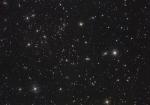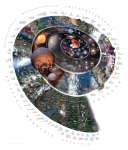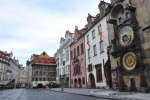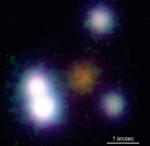
|
You entered: time
 Time Tunnel
Time Tunnel
6.09.2007
Spiky stars are nearby, but fuzzy galaxies are strewn far across the Universe in this cosmic view. Spanning about 1/2 degree on the sky, the pretty picture is the result of astronomer Johannes Schedler's project to look back in time, toward a quasar 12.7 billion light-years away.
 APOD: 2024 March 3 Б A Total Solar Eclipse Close Up in Real Time
APOD: 2024 March 3 Б A Total Solar Eclipse Close Up in Real Time
3.03.2024
How would you feel if the Sun disappeared? Many eclipse watchers across the USA surprised themselves in 2017 with the awe that they felt and the exclamations that they made as the Sun momentarily disappeared behind the Moon.
 APOD: 2024 July 1 Б Time Spiral
APOD: 2024 July 1 Б Time Spiral
1.07.2024
What's happened since the universe started? The time spiral shown here features a few notable highlights. At the spiral's center is the Big Bang, the place where time, as we know it, began about 13.8 billion years ago.
 SN Requiem: A Supernova Seen Three Times So Far
SN Requiem: A Supernova Seen Three Times So Far
2.11.2021
We've seen this same supernova three times -- when will we see it a fourth? When a distant star explodes in a supernova, we're lucky if we see it even once.
 An ALMA Telescope Array Time Lapse
An ALMA Telescope Array Time Lapse
26.05.2014
It is the most expensive and complex ground-based astronomy project ever -- what will it see tonight? The Atacama Large Millimeter Array (ALMA) project consists of 66 dishes, many the size of a small house, situated in the high altitude Atacama Desert in Northern Chile.
 The Prague Astronomical Clock
The Prague Astronomical Clock
7.11.2017
In the center of Prague there's a clock the size of a building. During the day, crowds gather to watch the show when it chimes in a new hour. The Prague Astronomical Clock...
 Antares
Antares
24.06.1997
Antares is a huge star. In a class called red supergiant, Antares is about 700 times the size of our own Sun, 15 times more massive, and 10,000 times brighter. Antares is the brightest star in the constellation of Scorpius and one of the brighter stars in all the night sky.
 Antares
Antares
26.07.1998
Antares is a huge star. In a class called red supergiant, Antares is about 700 times the diameter of our own Sun, 15 times more massive, and 10,000 times brighter. Antares is the brightest star in the constellation of Scorpius and one of the brighter stars in all the night sky.
 Equinox Sunrise Around the World
Equinox Sunrise Around the World
30.09.2022
A planet-wide collaboration resulted in this remarkable array of sunrise photographs taken around the September 2022 equinox. The images were contributed by 24 photographers, one in each of 24 nautical time zones around the world.
 PG 1115+080: A Gravitational Cloverleaf
PG 1115+080: A Gravitational Cloverleaf
31.03.1999
All four blue images in the above photograph are the same object. The gravitational lens effect of the red, foreground, elliptical galaxy visible near image center creates a cloverleaf image of the single distant quasar. Light from the quasar is pulled around the massive galaxy in different paths, corresponding to different images.
|
January February March April |
|||||||||||||||||||||||||||||||||||||||||||||||||